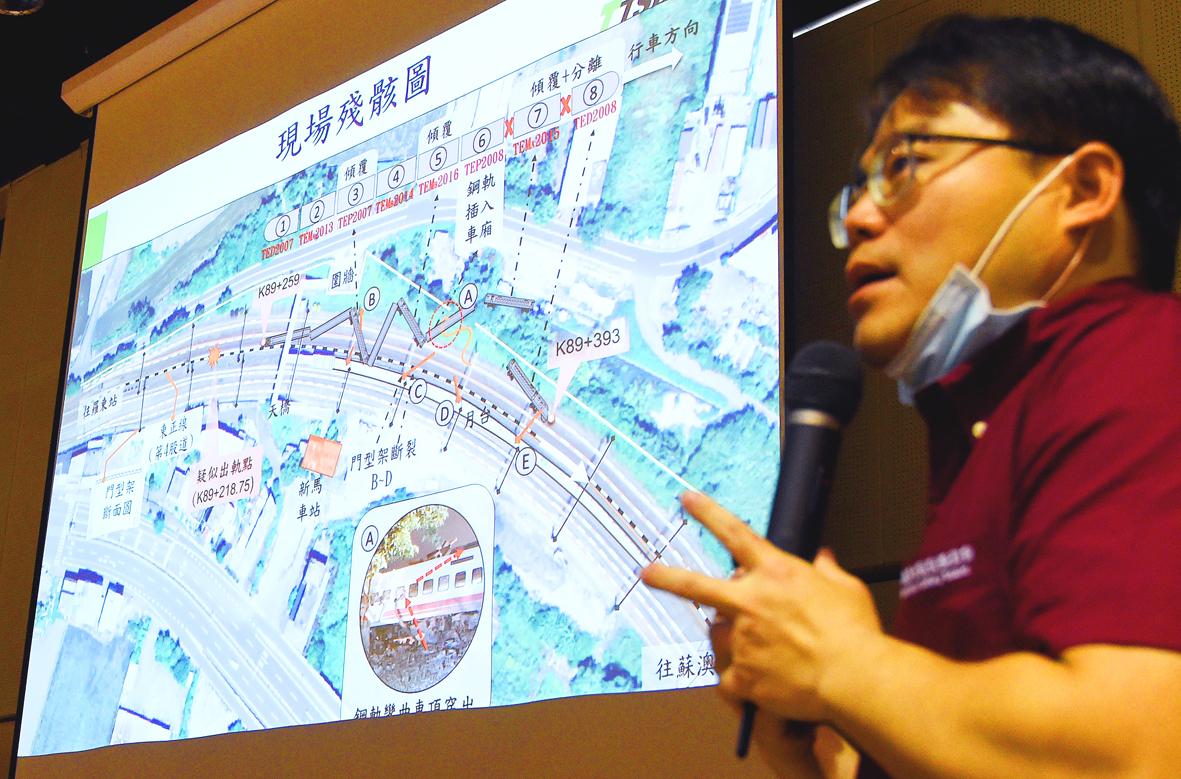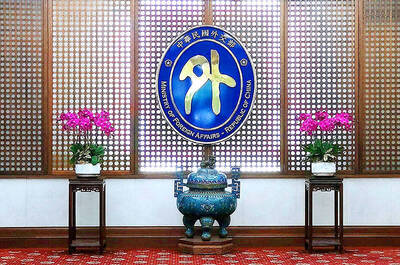The Taiwan Transportation Safety Board yesterday released a report on the deadly Puyuma Express derailment on Oct. 21, 2018, showing that the train was traveling at 140kph when it entered a curve ahead of Yilan County’s Sinma (新馬) Railway Station, adding that the driver tried to decelerate the train only one second before it derailed.
Eighteen people were killed in the accident and 291 were injured.
The Executive Yuan’s investigation report published on Dec. 21, 2018, failed to appease the relatives of the deceased, who accused the Taiwan Railways Administration of putting the blame solely on the driver.

Photo: Liao Chen-huei, Taipei Times
The agency reached settlements with the families of only two of the deceased, as well as the injured passengers.
The driver of Puyuma Express No. 6432 did not plead guilty. He said he was operating the train within the speed limit and that he had informed the agency that he had turned off the automatic train protection (ATP) system, which was designed to automatically slow down the train when it exceeded the speed limit.
When the Legislative Yuan on April 2 last year passed the Organic Act of the Taiwan Transportation Safety Board (國家運輸安全調查委員會組織法), it also passed a resolution to require the board, which was established on Aug. 1, to reinvestigate the derailment and identify root causes, as well as any systemic issues facing the railway agency.
The board’s report said that the tilting train began to experience intermittent power output about 49 minutes after it departed from the Shulin (樹林) Railway Station in New Taipei City at 2:50pm, adding that its parking brake activated automatically, stopping the train from time to time.
The train’s reservoir was also found to be lacking in air pressure, which resulted in its power supply being suspended 13 times before the derailment, data collected by the board showed.
The investigation found that the driver tried to find a solution after he reported the problem to the Fulong (福隆) Railway Station master in New Taipei City between 4:05pm and 4:07pm.
He turned off the ATP system at 4:17pm and did not switch it back on again, even though he was told at 4:26pm that the unstable power supply could have something to do with problems with air compressors.
The driver tried to boost the train’s power by gradually increasing its speed to 140kph and slowing it down again, and he performed the maneuver 10 times, the data showed.
At 4:49pm, the train tilted to the left and derailed on a curve before the Sinma Station, overturning four of its eight carriages.
Although the driver said he had notified the train deployment office that he had turned off the ATP, the report found that he did not report doing so until 4:47pm, about two minutes before the train derailed.
When the train was traveling between Yilan County’s Luodong Township (羅東) and the Sinma Station, the speed handle was placed at 140kph and the braking handle was placed at 0kph, the report said.
An analysis of train speed records suggested that the driver realized that the train was speeding only one second before the derailment, and he tried to quickly stop the train by moving the speed handle to the “off” position.
However, he did not move the brake handle, the report added.
The ATP was working properly, despite being turned off, the board said.
However, instead of showing that the ATP was turned off, the train control and monitoring system (TCMS) — designed by Toshiba Corp — showed that the device was “out of order,” which could have misled the driver into thinking that the train’s unstable power output was caused by a the ATP malfunctioning.
Neither the manufacturer’s instructions about the interface nor the TRA’s maintenance manual informs drivers that the ATP would be displayed as being “out of order” when it is turned off, the board added.
The train’s function to tilt when passing through curves was intact, the board said.
Two of the train’s four air compressors displayed the same error code at 12:38pm and 12:40pm respectively, but the driver who operated the train during the previous shift said that he did not report the problems because he did not notice them.
Therefore, the train departed from the Shulin Station on time, the board said.
Investigators also found that the malfunction in the air compressors was caused by foreign objects that had accumulated on the heat transfer fins of the coolers.
Degraded hollow fiber membrane filters and oil separators also prevented the air compressors from functioning normally, they said.
The board said that the report presents only factual information that it collected from data decoded from the ATP and the TCMS, images collected from surveillance cameras, and extensive interviews with stakeholders in the case.
It would present its final report in August, when it would detail potential causes of the accident and make safety recommendations, the board added.

The Ministry of Foreign Affairs (MOFA) yesterday voiced dissatisfaction with the Comprehensive and Progressive Agreement for Trans- Pacific Partnership (CPTPP), whose latest meeting, concluded earlier the same day, appeared not to address the country’s application. In a statement, MOFA said the CPTPP commission had "once again failed to fairly process Taiwan’s application," attributing the inaction to the bloc’s "succumbing to political pressure," without elaborating. Taiwan submitted its CPTPP application under the name "Separate Customs Territory of Taiwan, Penghu, Kinmen and Matsu" on Sept. 22, 2021 -- less than a week after China

THE GOOD WORD: More than 100 colleges on both sides of the Pacific will work together to bring students to Taiwan so they can learn Mandarin where it is spoken A total of 102 universities from Taiwan and the US are collaborating in a push to promote Taiwan as the first-choice place to learn Mandarin, with seven Mandarin learning centers stood up in the US to train and support teachers, the Foundation for International Cooperation in Higher Education of Taiwan (FICHET) said. At the annual convention of the American Council on the Teaching of Foreign Languages held over the weekend in New Orleans, Louisiana, a Taiwan Pavilion was jointly run by 17 representative teams from the FICHET, the Overseas Community Affairs Council, the Steering Committee for the Test of Proficiency-Huayu, the

A home-style restaurant opened by a Taiwanese woman in Quezon City in Metro Manila has been featured in the first-ever Michelin Guide honoring exceptional restaurants in the Philippines. The restaurant, Fong Wei Wu (豐味屋), was one of 74 eateries to receive a “Michelin Selected” honor in the guide, while one restaurant received two Michelin stars, eight received one star and 25 were awarded a “Bib Gourmand.” The guide, which was limited to restaurants in Metro Manila and Cebu, was published on Oct. 30. In an interview, Feng Wei Wu’s owner and chef, Linda, said that as a restaurateur in her 60s, receiving an

MORE RETALIATION: China would adopt a long-term pressure strategy to prevent other countries or future prime ministers following in Sanae Takaichi’s steps, an academic said Taiwan should maintain communications with Japan, as Japanese Prime Minister Sanae Takaichi is to lead a revision of security documents, Taiwanese academics said yesterday. Tensions have risen between Japan and China over remarks by Takaichi earlier this month that the use of force against Taiwan would constitute a “survival-threatening situation” for Japan. Prospect Foundation president Lai I-chung (賴怡忠) yesterday said Takaichi’s stance regarding Taiwan is the same as past Japanese prime ministers, but her position is clearer than that of her predecessors Fumio Kishida and Shigeru Ishiba. Although Japan views a “Taiwan contingency” as a “survival-threatening situation,” which would allow its military to